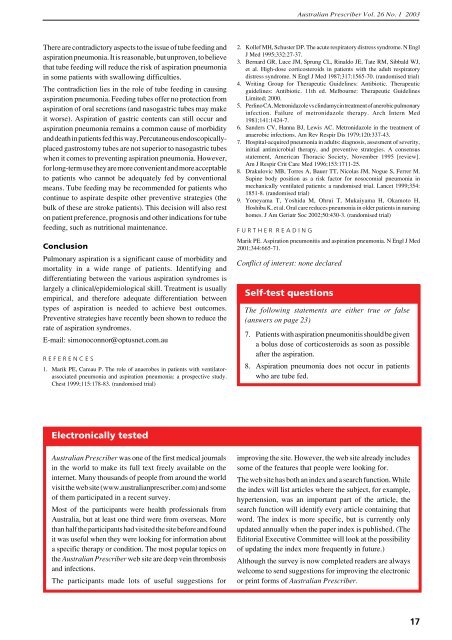Aspiration pneumonia and pneumonitis - Australian Prescriber
Aspiration pneumonia and pneumonitis - Australian Prescriber
Aspiration pneumonia and pneumonitis - Australian Prescriber
You also want an ePaper? Increase the reach of your titles
YUMPU automatically turns print PDFs into web optimized ePapers that Google loves.
There are contradictory aspects to the issue of tube feeding <strong>and</strong><br />
aspiration <strong>pneumonia</strong>. It is reasonable, but unproven, to believe<br />
that tube feeding will reduce the risk of aspiration <strong>pneumonia</strong><br />
in some patients with swallowing difficulties.<br />
The contradiction lies in the role of tube feeding in causing<br />
aspiration <strong>pneumonia</strong>. Feeding tubes offer no protection from<br />
aspiration of oral secretions (<strong>and</strong> nasogastric tubes may make<br />
it worse). <strong>Aspiration</strong> of gastric contents can still occur <strong>and</strong><br />
aspiration <strong>pneumonia</strong> remains a common cause of morbidity<br />
<strong>and</strong> death in patients fed this way. Percutaneous endoscopicallyplaced<br />
gastrostomy tubes are not superior to nasogastric tubes<br />
when it comes to preventing aspiration <strong>pneumonia</strong>. However,<br />
for long-term use they are more convenient <strong>and</strong> more acceptable<br />
to patients who cannot be adequately fed by conventional<br />
means. Tube feeding may be recommended for patients who<br />
continue to aspirate despite other preventive strategies (the<br />
bulk of these are stroke patients). This decision will also rest<br />
on patient preference, prognosis <strong>and</strong> other indications for tube<br />
feeding, such as nutritional maintenance.<br />
Conclusion<br />
Pulmonary aspiration is a significant cause of morbidity <strong>and</strong><br />
mortality in a wide range of patients. Identifying <strong>and</strong><br />
differentiating between the various aspiration syndromes is<br />
largely a clinical/epidemiological skill. Treatment is usually<br />
empirical, <strong>and</strong> therefore adequate differentiation between<br />
types of aspiration is needed to achieve best outcomes.<br />
Preventive strategies have recently been shown to reduce the<br />
rate of aspiration syndromes.<br />
E-mail: simonoconnor@optusnet.com.au<br />
R E F E R E N C E S<br />
1. Marik PE, Careau P. The role of anaerobes in patients with ventilatorassociated<br />
<strong>pneumonia</strong> <strong>and</strong> aspiration <strong>pneumonia</strong>: a prospective study.<br />
Chest 1999;115:178-83. (r<strong>and</strong>omised trial)<br />
Electronically tested<br />
<strong>Australian</strong> <strong>Prescriber</strong> was one of the first medical journals<br />
in the world to make its full text freely available on the<br />
internet. Many thous<strong>and</strong>s of people from around the world<br />
visit the web site (www.australianprescriber.com) <strong>and</strong> some<br />
of them participated in a recent survey.<br />
Most of the participants were health professionals from<br />
Australia, but at least one third were from overseas. More<br />
than half the participants had visited the site before <strong>and</strong> found<br />
it was useful when they were looking for information about<br />
a specific therapy or condition. The most popular topics on<br />
the <strong>Australian</strong> <strong>Prescriber</strong> web site are deep vein thrombosis<br />
<strong>and</strong> infections.<br />
The participants made lots of useful suggestions for<br />
<strong>Australian</strong> <strong>Prescriber</strong> Vol. 26 No. 1 2003<br />
2. Kollef MH, Schuster DP. The acute respiratory distress syndrome. N Engl<br />
J Med 1995;332:27-37.<br />
3. Bernard GR, Luce JM, Sprung CL, Rinaldo JE, Tate RM, Sibbald WJ,<br />
et al. High-dose corticosteroids in patients with the adult respiratory<br />
distress syndrome. N Engl J Med 1987;317:1565-70. (r<strong>and</strong>omised trial)<br />
4. Writing Group for Therapeutic Guidelines: Antibiotic. Therapeutic<br />
guidelines: Antibiotic. 11th ed. Melbourne: Therapeutic Guidelines<br />
Limited; 2000.<br />
5. Perlino CA. Metronidazole vs clindamycin treatment of anerobic pulmonary<br />
infection. Failure of metronidazole therapy. Arch Intern Med<br />
1981;141:1424-7.<br />
6. S<strong>and</strong>ers CV, Hanna BJ, Lewis AC. Metronidazole in the treatment of<br />
anaerobic infections. Am Rev Respir Dis 1979;120:337-43.<br />
7. Hospital-acquired <strong>pneumonia</strong> in adults: diagnosis, assesment of severity,<br />
initial antimicrobial therapy, <strong>and</strong> preventive strategies. A consensus<br />
statement, American Thoracic Society, November 1995 [review].<br />
Am J Respir Crit Care Med 1996;153:1711-25.<br />
8. Drakulovic MB, Torres A, Bauer TT, Nicolas JM, Nogue S, Ferrer M.<br />
Supine body position as a risk factor for nosocomial <strong>pneumonia</strong> in<br />
mechanically ventilated patients: a r<strong>and</strong>omised trial. Lancet 1999;354:<br />
1851-8. (r<strong>and</strong>omised trial)<br />
9. Yoneyama T, Yoshida M, Ohrui T, Mukaiyama H, Okamoto H,<br />
Hoshiba K, et al. Oral care reduces <strong>pneumonia</strong> in older patients in nursing<br />
homes. J Am Geriatr Soc 2002;50:430-3. (r<strong>and</strong>omised trial)<br />
F U R T H E R R E A D I N G<br />
Marik PE. <strong>Aspiration</strong> <strong>pneumonitis</strong> <strong>and</strong> aspiration <strong>pneumonia</strong>. N Engl J Med<br />
2001;344:665-71.<br />
Conflict of interest: none declared<br />
Self-test questions<br />
The following statements are either true or false<br />
(answers on page 23)<br />
7. Patients with aspiration <strong>pneumonitis</strong> should be given<br />
a bolus dose of corticosteroids as soon as possible<br />
after the aspiration.<br />
8. <strong>Aspiration</strong> <strong>pneumonia</strong> does not occur in patients<br />
who are tube fed.<br />
improving the site. However, the web site already includes<br />
some of the features that people were looking for.<br />
The web site has both an index <strong>and</strong> a search function. While<br />
the index will list articles where the subject, for example,<br />
hypertension, was an important part of the article, the<br />
search function will identify every article containing that<br />
word. The index is more specific, but is currently only<br />
updated annually when the paper index is published. (The<br />
Editorial Executive Committee will look at the possibility<br />
of updating the index more frequently in future.)<br />
Although the survey is now completed readers are always<br />
welcome to send suggestions for improving the electronic<br />
or print forms of <strong>Australian</strong> <strong>Prescriber</strong>.<br />
17

















